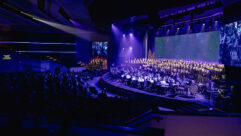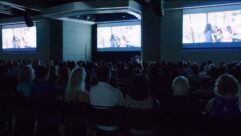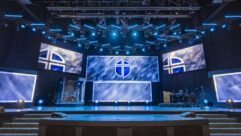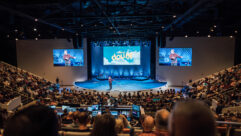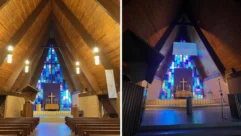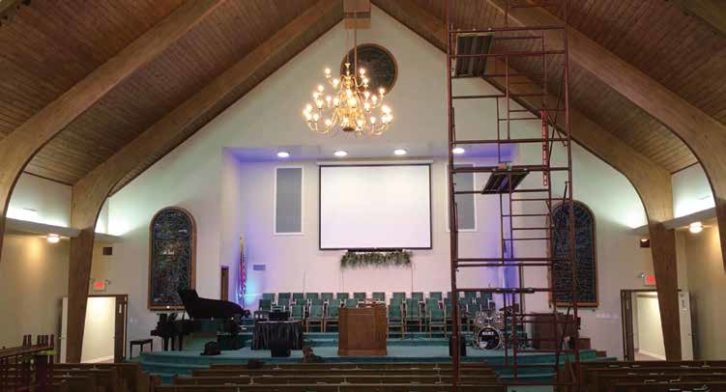
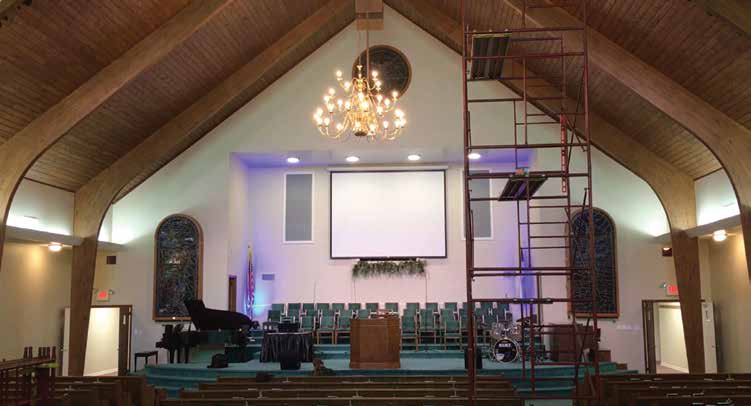
SVC: Carl, thanks for joining us. Can you describe what type of church Hillcrest Baptist is? Is it more of the contemporary sort with live music and all that?
Hillcrest is something you might actually consider somewhat of a hybrid. They are a traditional physical church with respect to architecture. They have a mixed service, however, where they straddle that line between traditional and contemporary in that they have full choir, soloists, organ/piano, along with some instrumentation, but not necessarily modern contemporary. They’re still very much a Southern Baptist-esque church, but they’ve mixed in the modern string instruments, percussion and others.
What sort of lighting setup did they already have? It sounds like when you came in there it was sort of a battle of the stained glass windows.
Yes. This is a very interesting church, and most listeners in this industry are probably well familiar with the 70’s or 80’s vintage glulam beam peaked roof, traditional church layout. And in this facility they actually have some very large stained glass windows in the rear of the church that face the worst cardinal direction possible where they get light both morning and night. And at certain times of year, when that light comes in just right, it basically cascades the entire sanctuary with blue and green stained glass coloration. As you can imagine in a traditional dark wood church with lighter fabrics or wall colors, those colors really begin to stand out, and in the worst case scenario, those colors actually encroach on the platform area. So it really adds an odd hue to the room that really skews the video coloration for what the viewer sees.
The light coming in from outside through those stained glass windows has got to be constantly changing as the day goes on.
Yes, all the time. And we’ve encountered this in a few locations and the hardest thing to always decipher is what is the worst case scenario? Because that typically happens when the stars align and everything is just right on a clear day. It’s very hard to gauge that variable, so what we did after a few visits onsite during nice, clear midday timetables, we determined roughly what our ambient lighting was that we needed to go against, and then added a little bit to that so we had some headroom to ensure that whatever light we were projecting on the platform was strong enough to give them traditional, nice, warm, white light.
So you had to come up with a lighting solution for the church and I think Quest Marketing in Miami Beach came into this. How did they come into the picture?
Yes. Quest and Matt down there, our rep, had helped us tremendously over the years. And in many cases our reps, of course, have used or seen products used in multiple ways where we might not have. So we leaned on Matt and Quest, and in the end elektraLite, in looking at some fixtures that would meet the aesthetics, the light output, and rough budgetary constraints. We had to give the customer a great performing solution, but also one that was low energy, excellent warranty period and likewise, one that was very aesthetically pleasing to the naked eye.
So you opted for the elektraLite Eyeball 5 in 1 LED fixtures. And I think the designation is ELE-729?
We ended up going with 10-degree beam angles on those fixtures, which worked extremely well. We were straddling that line in the church due to the layout having a platform at the long end of the church and glulam beams parallel with the front wall. There were only certain locations in which we could mount those fixtures. We had to determine, through the photometrics from elektraLite, what fixture would let us get the light we need, get the proper beam angle, and also allow us to mount a lightweight fixture up high, tight and out of the way so that the congregation wouldn’t have either trussing or anything else intrusive to the eye.
And it looks like they have a control interface that will work with several different methods of controlling those lights.
Yeah. They’ve got what has really become one of my favorite cost-effective lighting controllers for not just house of worship, but just about any entity needing to control anything from traditional dimming that’s DMX based all the way up to moving heads. That’s the Chauvet ShowXpress 512 Plus. That little unit is very easy to set up, use and train on, but it also gives us the ability to control the software via Windows or Mac-based operating systems, desktop or laptop via USB, when online with their network and their Wi-Fi. We actually have it set up so they can use the app-based phone control as well and then as a last resort redundancy, there is an infrared remote option from Chauvet that allows us to have an infrared remote preprogrammed with their scenes – up to 18 of them, I believe. So if the computer is off, it’s lost power, Heaven forbid, they could pull out that remote, simply engage their previously-set scenes and get back on the road immediately.
Well that’s always good to have a backup especially in a church situation where you’ve probably got a lot of volunteers working.
Absolutely. Hillcrest has a traditional volunteer staff, just like my home church. So of course training and operation is paramount, but having an easy, redundant way to turn the lights back on – literally – was a huge selling point in that scenario.
And when the LED instruments are brought all the way down on the control, they’re still on and you have them still using power.
Yes, exactly. Those fixtures, even though when fully dimmed, do go into somewhat of a standby mode. They still will draw incremental power so they are on as long as power is provided. That control, however, is a big deciding factor compared to traditional incandescent fixtures of the past where if the control went down maybe all you had to do was flip a breaker at the dimmer rack to manually energize them. That DMX protocol is the sole way to get those fixtures on unless you set up a loss-of-command scenario where if the fixtures lose DMX control they default to a preset. However, I’ve seen in some scenarios, for instance if you have fixtures that are always energized and turn off your control – be that a console or another device like the 512 Xpress, that the fixture is going to presume DMX is lost and go into that standby mode scene, which is not necessarily what you’d want in certain cases. So the benefit at Hillcrest is they have two 20-amp circuits—one per side of the lighting arrangement—actually wired into a switching system. So they can manually turn off power to those fixtures, whether the church is out for the week or times where they just want to save as much energy as possible. They can manually turn power feeding those fixtures off and ensure that they’re not drawing any current, and that nothing can happen to them or keep them on and lower their longevity.
I’m sure it was a much quicker and easier job since you were able to attach the lighting instruments to the actual structure of the church and not have to put up trusses.
Yes. One of the great benefits of the glulam beam architecture is that you have extremely sturdy, well-engineered wooden structures throughout the sanctuary, and in our case, given the eyeballs’ small size and its very, very low weight rating, we were able to affix those fixtures straight to the beams facing the platform so that congregation members, unless they looked straight up at them, would never even see them from the back of the church. So that, of course, saved on any rigging or trussing and labor-related as such. And it also kept the aesthetics of the sanctuary nice, clean, and pretty.
And probably kept the pastor from looking like a Smurf at various times of the day.
That is absolutely right. Combatting that blue-green hue of that stained glass window was really priority #1. Everything else with respect to control or redundant control benefits, energy conservation, and things of that nature was simply icing on the cake.
I think there are some control options for the fans on these instruments.

That is correct. With the elektraLite, like a few other manufacturers out there, you’re given a number of fan options. I believe in elektraLite’s case it’s an Off, Auto, Low, Normal, and High. And from our experience putting fixtures in houses of worship of this architecture, the major catalyst we know is always an issue is the HVAC system. Because in those spaces without a ceiling cavity we always see the heat rise, whether the heating element or cooling element is on. So we actually elected to place the fixtures in automatic mode. Due to that fluctuation of the ambient temperature, once you’ve reached about 12-15 foot overhead, that fluctuation and the angle the fixtures were mounted along the beam, basically gave us a scenario where they remained cool for long duration operation, and we kept the fans as quiet as possible when they didn’t need to cool. ElektraLite’s automatic mode actually works very, very, very well. It basically has the fans in a passive state for a large portion of the duration until the element heats up. Then it goes online and cools the fixture and will actually pad back down once the fixture is cool.
Do they do video recording there at the church?
Yes, sir. They actually have a really nice HD camera they record with in house. The lighting change from start to finish is actually a pretty substantial difference. It worked out extremely well in coverage, color saturation in areas where we want it, and white light really enveloping the pastor when he’s speaking. On video it is a noticeable difference and marked improvement from all those involved.
Did you need to do any sort of expansion to the electrical system for those?
The beauty of using those elektraLite eyeBall fixtures and their low-current draw with great output is we actually had the church use an in-house electrician, pull two 20-amp circuits for the 12 total fixtures – so that’s a 20-amp circuit per six fixtures. Thanks to that low current draw it was easily accessible for them to install power for us and we could also utilize their existing panel layout without drawing woefully more current. So it was extremely cost-effective and simple on their end. We basically have six eyeBalls, five-inones, ganged together through their included IEC power cables that all jump together and feed back to a common 20-amp circuit per six fixtures.
They needed a sound system improvement as well, correct?
Yes, we followed up with an entire frontend and loudspeaker replacement for the sanctuary sound system.
Okay, what did you do for the speakers in there?
We actually utilized in this space the Electro-Voice EVF line. And aside from selecting that speaker, the most predominant issues were related to what’s happened over time. The initial cluster was a multi-box Altec Lansing array comprised of separate components, center-cluster hung, which in the traditional sense of the church years ago, worked great. It was an excellent speech system. But somewhere along the way some chandeliers were added right down the middle and what we found upon our initial site survey was one of the biggest issues stemmed from the control booth. The chandeliers, oddly enough, were literally placed between the eyes of our frontof-house operator and the high-frequency drivers covering his location and those surrounding him. So our sound op had basically no high end making it to him, making his ability to mix and equalize extremely difficult. So we used the EVF series in a three-box hang with two mono clusters; one left and one right of the room. Those two clusters basically bisect the seating plane and also allow us to once again provide high frequencies to our sound operator now that we are working around those chandeliers.
And one of the trickier things in church sound systems is always going to be the choir monitoring.
Oh, yes. The church has an interesting choir loft in that it’s only about 10-foot deep. It’s at least about 20-foot wide, but their ceiling is extremely tall. Previously the old cluster used a single down-firing horn with a woofer, which actually went a little beyond the choir. It caused some reflections and was a little much for the SPL the choir needed. They were getting a lot of stage volume. Likewise, since they had tiered seating, floor monitors or traditional floor wedges just really wouldn’t provide the coverage given they didn’t have a splayed seating arrangement. Nor was the inclination appropriate for such. So to combat this, we implemented a trick we’ve used for a few years in these cases where we actually use some Electro-Voice ZX1 install white models mounted on the sidewalls of the choir loft shooting in. This allowed us to place a speaker at a common point over each half of the choir where SPL and coverage was almost equivalent within 3 dB to each listener. And then in conjunction with that mix, we have a center choir floor box with a black Electro-Voice ZX190 that allows us to use that separate mix for either a center choir fill in case they have soloists that are standing in the aisle-way, or to be turned around and used as a music minister, pastor or band or contemporary band member monitor mix.
Live music to whatever degree it’s used always makes things much more challenging for the monitoring. Do you have a separate monitor mix for the pulpit area?
Yes. They actually initially had two mixes, one being the overhead choir mix and then a front monitor mix for the pulpit. What we transitioned to was our side-mounted choir monitor mix, the center choir floor mix, and then the platform mix remained, but we actually added some Mystery Electronics FMCA 1000 floor boxes at a couple of strategic locations with literally probably the shortest monitor cords I’ve ever made—about two feet—going to a couple of ZX190s there as well. And the intention, as part of the more contemporary scenario in the church, is to clean up the platform and make it look aesthetically pleasing. So by placing our FMCA 1000 boxes at strategic locations picked by the church for their use using short cords and the ZX1s, we’re able to provide an excellent-sounding, very high SPL monitor that to the naked eye was very hidden, no cables were present any longer.
That’s incredible the way you came in and did all of this. How long did you have to get it all done?
This was one of those lovely week-long jobs. We came in on a Monday and me and the guys and Mark, our president and owner, actually finished out that Saturday.
I guess a lot of that or a significant part of it was running cable.
Yes. Believe it or not, of all things a lot of these churches of this vintage, that’s ‘70’s-‘80’s glulam beam, peaked room sanctuary traditionally always have their air ducts run down the left and right of the sanctuary with access hatches. So over the years we’ve learned and followed actually the same path as the previous installer; that air duct chase is a way to get our cabling in. In all honesty we probably were able to run our speaker cabling within a lesser time table it took to load in all the gear.
And you have Ashly amps running everything?
Yes. In order to keep costs down as much as possible for the customer, we utilized new Ashly KLR5000s on the subwoofers and house system, and then reused three of their old Crown Macro series amplifiers for monitors, their 70-volt system, and other ancillary speaker circuits.
I wouldn’t think you could get all of that done in a week’s time with both lighting and sound.
There’s a lot of that that really does come back to pre-job planning and engineering – and I’ll toot their horn a little bit – Polar Focus actually supplied us with some custom bracketry to affix to the glulam beams which literally made hanging the arrays a single drill scenario. Very quick and efficient, very easy to manipulate and mount into place. And in doing such, without the traditional methods of either part affixation, aerial cable chain, what have you, it gave us a platform to mount to rapidly using a lift and really expedited our timetable.


